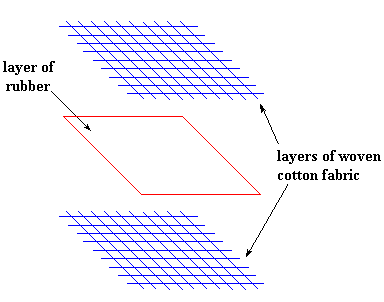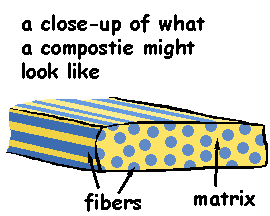
|
|
A composite is any material made of at least two other materials. There are a lot of composites around you. Concrete is a composite. It's made of cement, gravel, and sand, and often has steel rods inside to make it stronger. Those shiny balloons you get in the hospital when you're sick are made of a composite, which consists of a polyester sheet and an aluminum foil sheet, made into a sandwich.
These are composites made from polymers, or from polymers along with other kinds of materials. One of the most common types is fiber-reinforced composites. These are materials in which a fiber made of one material is embedded in another material. Why would we do this? Let's find out...
One of the first fiber-reinforced polymer composites made by humans was a raincoat. It was created in the middle of the nineteenth century, by a Scottish fellow by the name of Charles Macintosh, who came up with a clever idea...

 He took two layers of cotton fabric and embedded them in
natural rubber,
making a three-layered sandwich like the one you see on your right.
(Remember, cotton is a
form of a natural polymer called cellulose.)
This made for good raincoats because, while the rubber made it
waterproof, the cotton layers made it comfortable to wear. To this day,
a raincoat in Britain is referred to as a "macintosh", or just a "mack"
for short.
He took two layers of cotton fabric and embedded them in
natural rubber,
making a three-layered sandwich like the one you see on your right.
(Remember, cotton is a
form of a natural polymer called cellulose.)
This made for good raincoats because, while the rubber made it
waterproof, the cotton layers made it comfortable to wear. To this day,
a raincoat in Britain is referred to as a "macintosh", or just a "mack"
for short.
You see, that's why we make composites: to make a material that acts like both of its parts only better together. That kind of mutual support is called "synergy." In this case, we combine the water-resistance of rubber and the comfort of cotton.
 Composites are usually made of two parts, a fiber and a
matrix. The fiber can be glass, Kevlar, carbon fiber, or
polyethylene. The matrix, which is the stuff that holds the fibers together, is usually a thermoset like an epoxy
resin. The fiber is embedded in the matrix
in order to make the matrix stronger. Fiber-reinforced composites have
two things going for them. They are strong and they are relatively light. They're often
stronger than steel, but weigh much less. This means that composites can
be used to make automobiles lighter, so they use less fuel but still protect you in a crash.
Composites are usually made of two parts, a fiber and a
matrix. The fiber can be glass, Kevlar, carbon fiber, or
polyethylene. The matrix, which is the stuff that holds the fibers together, is usually a thermoset like an epoxy
resin. The fiber is embedded in the matrix
in order to make the matrix stronger. Fiber-reinforced composites have
two things going for them. They are strong and they are relatively light. They're often
stronger than steel, but weigh much less. This means that composites can
be used to make automobiles lighter, so they use less fuel but still protect you in a crash.
Composites can also be used to imitate natural materials, like in musical instruments where use of wood is common. But wood can be expensive such as the rare kinds used in a nice violin. Wood can also be unpredictable, like in a wood reed for a saxophone or clarinet. Some reeds work fine, some don't no matter what you do with them. Composites made of straight fibers surrounded by special epoxy resins can look and act a lot like wood; they also last longer and may perform better.

|
Return to Level Three |

|
Return to Main Page |